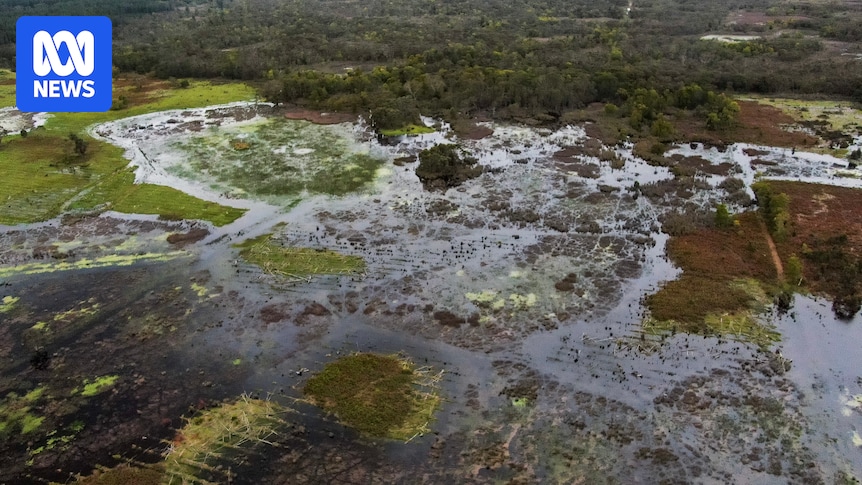Amid a dry year in South Australia’s South East, one place is giving conservationists some hope for the future.
The Nature Glenelg Trust (NGT) took over Mount Burr Swamp, about 40 kilometres from Mount Gambier, in 2016.
In 2018, it purchased an additional parcel of land to create the 370-hectare property the trust looks after today.
What the swamp looked like following a dry summer in May 2023. (Supplied: Mark Bachmann)
How the swamp looked in July 2023 after restoration work and rainfall. (Supplied: Mark Bachmann)
Now, with some much-needed rain and shallow groundwater, the newest section of the swamp is full and thriving.
NGT senior ecologist Brian Haywood said the signs were already encouraging.
“We’ve observed migratory birds like the Latham’s snipe in August and September. That’s a declining global species,” he said.
Brian Haywood has overseen the swamp restoration. (ABC South East SA: Sam Bradbrook)
“Certainly, the frogs are loving it. The chorus has been pretty loud today and has been for the past few months.”Wildlife coming home
In the 1960s, the Mount Burr Swamp area was drained to make way for farming and forestry plantations.
When the NGT took it over, staff and volunteers got to work blocking drainage channels to allow water to gather on the land.
The swamp still hosts some active farmland, which will be slowly transformed back into part of the wetland. (ABC South East SA: Sam Bradbrook)
“The stage two area is at capacity and we’re really chuffed with that because it will start to make the aquatic vegetation do its thing,” Mr Haywood said.
“It will start to remove a lot of the pasture grasses and weedy species that have moved down that gradient from the shoreline of the wetlands down to the basin.”
The area’s restoration has conservationists and researchers excited about what rare and vulnerable animals might make it their home.
University of Sydney emeritus professor Mike Thompson has been researching freshwater turtles since the 1980s.
Mike Thompson says data on freshwater turtles outside major river systems is lacking. (ABC South East SA: Sam Bradbrook)
He said restoring the wetland would help the eastern long-necked turtle return to the swamp.
“Restoring the entire habitat means restoring turtle populations to healthy populations,” he said.
The eastern long-necked turtle has been spotted in Mount Burr Swamp before. (Supplied: Deborah Bower)
“Because eastern long-necked turtles move around a lot, they will reinhabit this area naturally.
“It will take time, but the turtles walking around will eventually find their way back here.”
Tougher times ahead
While the newest area of Mount Burr Swamp is thriving, other wetlands in the region are still feeling the effects of a hot and dry start to 2025.
Next door, the original lagoon’s water levels are below what the NGT would expect during October.
NGT founder and manager Mark Bachmann said it was likely groundwater sat closer to the surface on the newer part of the swamp, meaning the older section needed more rain to catch up.
The original wetland area of Mount Burr Swamp was full in 2021. (Supplied: Nature Glenelg Trust)
The same area of Mount Burr Swamp in October 2025. (ABC South East SA: Sam Bradbrook)
“Probably the exception is the coastal zone, where wetlands are a bit more responsive to rainfall over shorter periods of time,” he said.
“The water table isn’t as far down, even if the amount of water passing through the places where we have springs has definitely reduced over time.
“As soon as you get inland anywhere, the wider trends that are happening in the region with groundwater really start to come to the fore.”
Mr Bachmann said warmer temperatures, declining groundwater levels and varying rainfall made caring for wetlands difficult.
Mark Bachmann says improving wetlands is important. (Supplied: Liz Fenton)
“Pretty much everyone in the region relies on groundwater in one shape or form,” he said.
“Because we don’t have as many areas in the landscape where water is able to infiltrate and recharge that aquifer, it does mean we’re all relying on a resource that’s definitely under stress.”
Ensuring the future
Back at Mount Burr Swamp, volunteers young and old got to work planting trees and learning about the swamp’s waterbugs.
Helen Bawden and Sue Black have been volunteering at Mount Burr Swamp since NGT first took it over in 2016.
Sue Black and Helen Bawden are passionate about maintaining the swamp. (ABC South East SA: Sam Bradbrook)
Ms Bawden said getting the community invested in wetland survival was vital for keeping them healthy.
“It’s nice to have farming land, but you clear everything off and you’ve got no shade in the paddocks. In the hot sun, it’s pretty merciless,” Ms Bawden said.
Volunteers planted native trees and grasses to restore the land to its original state. (ABC South East SA: Sam Bradbrook)
“You just need these sort of places to keep it hydrated, have insects and birds.
“I am just so enthusiastic about all this.”

